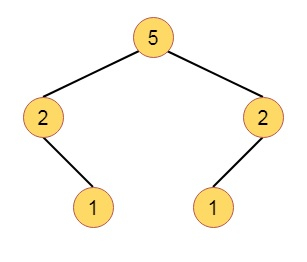
 Data Structure
Data Structure Networking
Networking RDBMS
RDBMS Operating System
Operating System Java
Java MS Excel
MS Excel iOS
iOS HTML
HTML CSS
CSS Android
Android Python
Python C Programming
C Programming C++
C++ C#
C# MongoDB
MongoDB MySQL
MySQL Javascript
Javascript PHP
PHP
- Selected Reading
- UPSC IAS Exams Notes
- Developer's Best Practices
- Questions and Answers
- Effective Resume Writing
- HR Interview Questions
- Computer Glossary
- Who is Who
Weight-Biased Leftist Trees in Data Structure
Here we will see another variation of Leftist Tree. Here we will consider the number of nodes in a subtree, rather than the length of a shortest path for root to external node. Here we will define the weight w(x) of node x, to be the number of internal nodes in the subtree with root x. If x is an external node, then the weight is 0. If x is internal node, then the weight is one more than the sum of weights of its children.
Here is an example of Weight Biased Leftist Tree (WBLT) −
Suppose the Binary tree is like this −

If we calculate w(x) values for each node, it will be like this −

Now the definition of WBLT is like −
A binary tree is called Weight Balanced Leftist Tree if and only if, at every internal node the w(x) of left child is greater than or equal to the w(x) of the right child. A max (min) WBLT is a max (min) tree that is also a WBLT.

